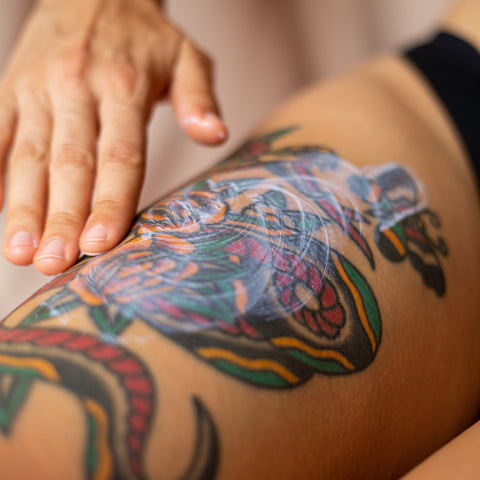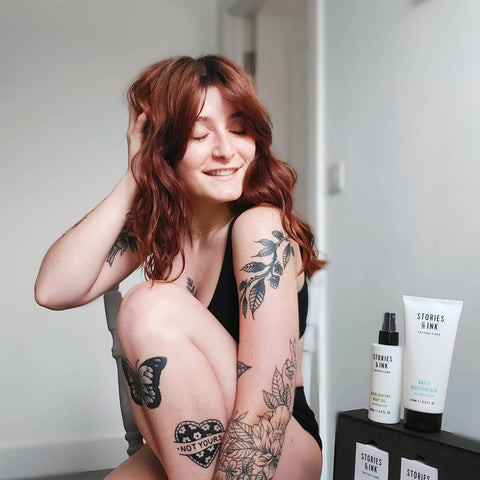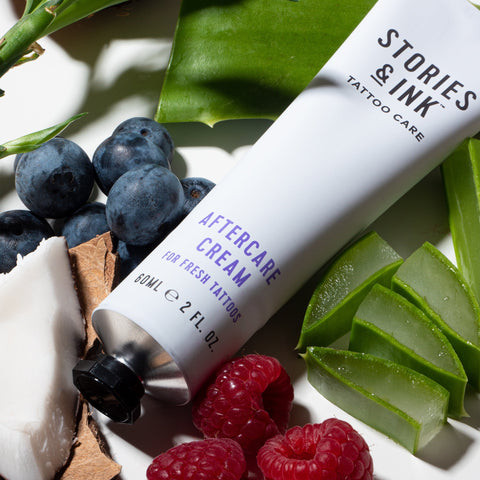Can You Over Moisturize Your Tattoo? Absolutely, over-moisturizing a new tattoo is a common mistake that can hinder the healing process. At tattooat.com, we’re dedicated to providing guidance on proper tattoo aftercare, ensuring your body art remains vibrant and healthy by finding tattoo shops near you. This guide delves into the risks of over-moisturizing, how to identify the issue, and effective solutions, plus tips for optimal tattoo healing, skincare routines, and long-term tattoo maintenance.
1. Understanding the Importance of Tattoo Aftercare
Proper tattoo aftercare is crucial for ensuring that your new ink heals correctly and remains vibrant for years to come. The first few weeks after getting a tattoo are particularly important, as this is when your skin is most vulnerable. A well-maintained aftercare routine helps prevent infections, reduces scarring, and keeps your tattoo looking its best. Key aspects of tattoo aftercare include gentle cleaning, proper moisturizing, and avoiding direct sunlight.
1.1. The Role of Moisturizing in Tattoo Healing
Moisturizing plays a vital role in the tattoo healing process. It helps to keep the skin hydrated, which in turn reduces itching and prevents the formation of thick scabs. Proper hydration also promotes faster cell regeneration, aiding in the overall healing of the tattooed area. However, it’s essential to strike a balance; too little moisture can lead to dryness and cracking, while too much can create an environment conducive to bacterial growth.
1.2. Common Tattoo Aftercare Mistakes
Many people make common mistakes when caring for their new tattoos, often due to misinformation or lack of awareness. Some of these mistakes include using harsh soaps, not cleaning the tattoo regularly, exposing it to direct sunlight, and, as we’ll discuss in detail, over-moisturizing. Understanding these pitfalls is the first step in ensuring a smooth and successful healing process.
2. Can You Over Moisturize Your Tattoo? Identifying Over-Moisturization
Yes, you absolutely can over-moisturize a tattoo. While moisturizing is essential for proper healing, applying too much moisturizer can lead to a range of problems. Recognizing the signs of over-moisturization is crucial for taking corrective action and preventing complications.
2.1. Signs of an Over-Moisturized Tattoo
Identifying an over-moisturized tattoo involves looking for specific signs and symptoms. These can include:
- Redness and Inflammation: The skin around the tattoo may appear excessively red and inflamed.
- Small Bumps or Breakouts: Tiny, pimple-like bumps may form on or around the tattoo.
- Soggy Appearance: The tattooed area might look or feel soggy, indicating that the skin is overly saturated with moisture.
- Blurred Ink: The lines of the tattoo may appear less defined or blurred.
- Delayed Healing: The healing process may seem slower than expected, with scabs taking longer to fall off.
2.2. Why Over-Moisturizing is Harmful
Over-moisturizing can create several problems for a healing tattoo. Excess moisture traps bacteria, increasing the risk of infection. It can also clog pores, leading to breakouts and skin irritation. Furthermore, overly hydrated skin is more prone to damage, potentially affecting the tattoo’s appearance.
**2.3. Comparing Over-Moisturization to Other Tattoo Problems
It’s important to differentiate over-moisturization from other common tattoo issues. For instance, an infected tattoo will typically present with severe redness, swelling, pain, and possibly pus. Allergic reactions can cause intense itching and a rash. Dryness, on the other hand, will lead to flaky skin and tight discomfort. Recognizing these differences will help you address the specific problem effectively.
3. The Science Behind Tattoo Healing and Moisturizing
Understanding the science behind tattoo healing and moisturizing can help you make informed decisions about your aftercare routine. This involves knowing how the skin repairs itself after a tattoo and how moisturizing agents assist in this process.
3.1. How Tattoos Affect the Skin
When you get a tattoo, the needles penetrate the epidermis (outer layer of skin) and deposit ink into the dermis (deeper layer). This process creates thousands of tiny wounds, triggering the body’s natural healing response. The skin cells work to repair the damage, forming new tissue and pushing out foreign substances, like excess ink.
3.2. The Skin’s Natural Healing Process
The skin’s healing process involves several stages, including inflammation, proliferation, and remodeling. During inflammation, the body sends immune cells to the area to fight off infection and clear debris. In the proliferation stage, new skin cells are generated to close the wound. Finally, the remodeling phase involves the reorganization of collagen fibers to strengthen the skin.
3.3. How Moisturizers Aid Healing
Moisturizers help this process by keeping the skin hydrated and supple. Hydrated skin cells can regenerate more efficiently, leading to faster healing. Moisturizers also create a protective barrier that keeps out harmful bacteria and irritants. Look for moisturizers that are non-comedogenic, fragrance-free, and hypoallergenic to minimize the risk of adverse reactions.
4. How Often Should You Moisturize Your Tattoo?
Finding the right balance in moisturizing is essential. While there’s no one-size-fits-all answer, general guidelines can help you determine the appropriate frequency.
4.1. General Guidelines for Moisturizing
Typically, moisturizing a new tattoo 2-3 times a day is sufficient. However, this can vary depending on factors such as skin type, climate, and the specific moisturizer you’re using. It’s best to apply a thin layer of moisturizer after cleaning the tattoo and allowing it to air dry.
4.2. Factors Influencing Moisturizing Frequency
- Skin Type: Dry skin may require more frequent moisturizing than oily skin.
- Climate: Dry, cold weather can necessitate more moisturizing, while humid conditions may reduce the need.
- Type of Moisturizer: Thicker, more occlusive moisturizers may only need to be applied once or twice a day.
- Tattoo Location: Areas prone to friction, such as the inner thigh, may benefit from more frequent moisturizing.
4.3. Listening to Your Skin
Ultimately, the best way to determine how often to moisturize is to pay attention to your skin’s needs. If your tattoo feels tight or itchy, it may need more moisture. If it looks or feels soggy, you’re likely over-moisturizing. Adjust your routine accordingly.
5. Choosing the Right Moisturizer for Your Tattoo
Selecting the right moisturizer is crucial for promoting healthy tattoo healing. Not all products are created equal, and some may even hinder the healing process.
5.1. Ingredients to Look For
Look for moisturizers that contain beneficial ingredients such as:
- Panthenol (Vitamin B5): Helps to hydrate and soothe the skin.
- Glycerin: A humectant that draws moisture to the skin.
- Shea Butter: A rich emollient that helps to soften and protect the skin.
- Aloe Vera: Known for its soothing and anti-inflammatory properties.
5.2. Ingredients to Avoid
Avoid moisturizers that contain:
- Fragrances: Can cause irritation and allergic reactions.
- Alcohol: Can dry out the skin.
- Petroleum-Based Products: Can clog pores and prevent the skin from breathing.
- Artificial Colors: Can cause allergic reactions.
5.3. Recommended Tattoo Moisturizers
Several moisturizers are specifically designed for tattoo aftercare. These products are typically fragrance-free, non-comedogenic, and contain ingredients that promote healing. Some popular options include:
- Stories & Ink Aftercare Cream: Formulated to soothe, calm, and repair damaged skin.
- Aquaphor Healing Ointment: A classic choice for tattoo aftercare, known for its moisturizing and protective properties.
- Cetaphil Moisturizing Cream: A gentle, non-irritating option for sensitive skin.
 Moisturizing a tattoo
Moisturizing a tattoo
6. Steps to Fix an Over-Moisturized Tattoo
If you suspect that you’ve over-moisturized your tattoo, don’t panic. Here are steps you can take to remedy the situation.
6.1. Gently Clean the Area
Start by gently cleaning the tattoo with a mild, fragrance-free soap and lukewarm water. Use your fingertips to gently massage the area, removing any excess moisturizer or debris.
6.2. Pat Dry with a Clean Towel
After cleaning, pat the tattoo dry with a clean, soft towel. Avoid rubbing, as this can irritate the skin. Ensure that the area is completely dry before proceeding.
6.3. Allow the Tattoo to Air Dry
Leave the tattoo exposed to air for about 10-15 minutes. This allows any remaining moisture to evaporate and helps the skin breathe.
6.4. Hold Off on Moisturizing
Refrain from applying any moisturizer for the rest of the day. This gives the skin a chance to recover and rebalance its moisture levels.
6.5. Resume Moisturizing the Next Day
The next day, resume your regular moisturizing routine, but be mindful of applying a thinner layer of moisturizer. Monitor your skin for any signs of over-moisturization and adjust your routine as needed.
7. Preventing Over-Moisturization: Best Practices
Prevention is always better than cure. By following these best practices, you can avoid over-moisturizing your tattoo and ensure a smooth healing process.
7.1. Apply Thin Layers of Moisturizer
When moisturizing, use only a small amount of product and spread it evenly over the tattoo. The goal is to create a thin, breathable barrier, not to saturate the skin.
7.2. Ensure the Tattoo is Dry Before Moisturizing
Always make sure that your tattoo is completely dry before applying moisturizer. This prevents moisture from being trapped under the moisturizer, which can lead to over-hydration.
7.3. Avoid Occlusive Dressings
Unless specifically recommended by your tattoo artist or a healthcare professional, avoid using occlusive dressings or bandages on your tattoo. These can trap moisture and increase the risk of over-moisturization and infection.
7.4. Monitor Your Skin Regularly
Pay close attention to your skin’s condition and adjust your aftercare routine accordingly. If you notice any signs of over-moisturization, take corrective action immediately.
 UGC-kit_50d25ce4-2729-4b63-9b85-3261abc17e1f_480x480
UGC-kit_50d25ce4-2729-4b63-9b85-3261abc17e1f_480x480
8. Other Essential Tattoo Aftercare Tips
In addition to proper moisturizing, there are several other essential aftercare tips that you should follow to ensure your tattoo heals correctly.
8.1. Keep the Tattoo Clean
Clean your tattoo 2-3 times a day with a mild, fragrance-free soap and lukewarm water. Gently massage the area to remove any bacteria or debris.
8.2. Avoid Direct Sunlight
Protect your tattoo from direct sunlight, as UV rays can fade the ink and damage the skin. Wear loose-fitting clothing or apply a tattoo-specific sunscreen with a high SPF.
8.3. Stay Hydrated
Drinking plenty of water helps to keep your skin hydrated from the inside out, promoting faster healing.
8.4. Avoid Picking or Scratching
Resist the urge to pick or scratch your tattoo, as this can lead to scarring and infection. If your tattoo is itchy, gently pat the area instead.
8.5. Wear Loose-Fitting Clothing
Wear loose-fitting clothing to avoid friction and irritation. Tight clothing can rub against the tattoo, causing discomfort and potentially delaying healing.
9. What to Do If You Suspect a Tattoo Infection
Despite your best efforts, tattoo infections can still occur. It’s important to recognize the signs of infection and seek medical attention promptly.
9.1. Signs of a Tattoo Infection
- Severe Redness and Swelling: The skin around the tattoo is excessively red and swollen.
- Persistent Pain: The tattoo is increasingly painful to the touch.
- Pus or Drainage: There is yellowish or greenish pus draining from the tattoo.
- Fever: You develop a fever or chills.
- Red Streaks: Red streaks appear radiating from the tattoo.
9.2. When to See a Doctor
If you experience any of these symptoms, see a doctor immediately. Tattoo infections can be serious and may require antibiotics or other medical treatment.
9.3. Preventing Infections
The best way to prevent tattoo infections is to follow proper aftercare procedures and choose a reputable tattoo artist who adheres to strict hygiene standards. Always ensure that the tattoo studio uses sterile equipment and follows proper sanitation protocols.
10. Long-Term Tattoo Care and Maintenance
Once your tattoo has fully healed, it’s important to continue caring for it to keep it looking its best.
10.1. Regular Moisturizing
Continue to moisturize your tattoo regularly, especially after showering or swimming. This helps to keep the skin hydrated and prevents the ink from fading.
10.2. Sun Protection
Protect your tattoo from the sun by wearing sunscreen or protective clothing. UV rays can cause the ink to fade and damage the skin over time.
10.3. Exfoliation
Gently exfoliate your tattoo to remove dead skin cells and keep the ink looking vibrant. Avoid using harsh scrubs or chemicals that can irritate the skin.
10.4. Staying Hydrated
Continue to drink plenty of water to keep your skin hydrated and healthy.
10.5. Touch-Ups
Over time, tattoos may fade or become less defined. Consider getting touch-ups every few years to keep your tattoo looking its best.
 Aftercare_Cream_12_019e9766-50a6-4317-beb2-ddc70f2260ad_480x480
Aftercare_Cream_12_019e9766-50a6-4317-beb2-ddc70f2260ad_480x480
Navigating the world of tattoo aftercare can feel overwhelming, but with the right knowledge and practices, you can ensure your ink heals beautifully and lasts a lifetime. Remember, moderation is key when it comes to moisturizing, and paying attention to your skin’s needs will help you strike the perfect balance.
FAQ: Over-Moisturizing Your Tattoo
1. What happens if I over-moisturize my tattoo?
Over-moisturizing your tattoo can lead to clogged pores, breakouts, inflammation, and a higher risk of infection. The skin may also appear soggy, and the tattoo ink might look blurred.
2. How do I know if I’m over-moisturizing my tattoo?
Signs of over-moisturization include redness, inflammation, small bumps, a soggy appearance, and blurred ink. If you notice any of these symptoms, reduce the frequency of moisturizing.
3. Can over-moisturizing cause a tattoo infection?
Yes, over-moisturizing can create an environment conducive to bacterial growth, increasing the risk of infection.
4. What should I do if I think I’ve over-moisturized my tattoo?
Gently clean the area with mild soap and water, pat it dry, and allow it to air dry. Refrain from moisturizing for the rest of the day, and resume your regular routine the next day, using a thinner layer of moisturizer.
5. How often should I moisturize my new tattoo?
Generally, moisturizing 2-3 times a day is sufficient. However, this can vary depending on your skin type, climate, and the type of moisturizer you’re using.
6. What type of moisturizer is best for tattoos?
Choose a fragrance-free, non-comedogenic, and hypoallergenic moisturizer. Look for ingredients like panthenol, glycerin, shea butter, and aloe vera.
7. Can I use Aquaphor on my tattoo?
Yes, Aquaphor is a popular choice for tattoo aftercare due to its moisturizing and protective properties. However, use it sparingly to avoid over-moisturization.
8. Is it better to let my tattoo air dry or pat it dry after cleaning?
It’s best to pat your tattoo dry with a clean, soft towel and then allow it to air dry for a few minutes before applying moisturizer.
9. How long should I continue moisturizing my tattoo?
Continue moisturizing your tattoo throughout the healing process, which typically lasts 2-4 weeks. Once the tattoo is fully healed, you can continue to moisturize it regularly to keep the skin hydrated and the ink vibrant.
10. Can I use regular lotion on my tattoo after it’s healed?
Yes, once your tattoo is fully healed, you can use a regular, fragrance-free lotion to keep the skin hydrated. However, avoid using products that contain harsh chemicals or irritants.
Ready to take the next step in your tattoo journey? Visit tattooat.com to explore a vast array of tattoo designs, discover talented artists, and access expert advice on all things tattooing. Whether you’re seeking inspiration for your next piece or need guidance on aftercare, tattooat.com is your ultimate resource. Contact us at Address: 1825 SW Broadway, Portland, OR 97201, United States. Phone: +1 (503) 725-3000.